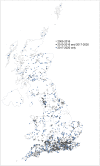Mapping and monitoring tick (Acari, Ixodida) distribution, seasonality, and host associations in the United Kingdom between 2017 and 2020
- PMID: 36309852
- PMCID: PMC10092223
- DOI: 10.1111/mve.12621
Mapping and monitoring tick (Acari, Ixodida) distribution, seasonality, and host associations in the United Kingdom between 2017 and 2020
Abstract
Tick-borne disease risk is intrinsically linked to the distribution of tick vector species. To assess risk and anticipate disease emergence, an understanding of tick distribution, host associations, and seasonality is needed. This can be achieved, to some extent, using passive surveillance supported by engagement with the public, animal health, and public health experts. The Tick Surveillance Scheme (TSS) collects data and maps tick distribution across the United Kingdom (UK). Between 2017 and 2020, 3720 tick records were received and 39 tick species were detected. Most records were acquired in the UK, with a subset associated with recent overseas travel. The dominant UK acquired species was Ixodes ricinus (Ixodida: Ixodidae, Linnaeus), the main vector of Lyme borreliosis. Records peaked during May and June, highlighting a key risk period for tick bites. Other key UK species were detected, including Dermacentor reticulatus (Ixodida: Ixodidae, Fabricius) and Haemaphysalis punctata (Ixodida: Ixodidae, Canestrini & Fanzago) as well as several rarer species that may present novel tick-borne disease risk to humans and other animals. Updated tick distribution maps highlight areas in the UK where tick exposure has occurred. There is evidence of increasing human tick exposure over time, including during the COVID-19 pandemic, but seasonal patterns remain unchanged.
Keywords: Ixodes ricinus; Lyme borreliosis; citizen science; mapping; public health; recording.
© 2022 Crown copyright. Medical and Veterinary Entomology published by John Wiley & Sons Ltd on behalf of Royal Entomological Society. This article is published with the permission of the Controller of HMSO and the King's Printer for Scotland.
Figures







References
-
- Barton, K. , 2020. MuMIn: Multi‐Model Inference. R Package.
-
- Borșan, S.‐D. , Trif, S.R. & Mihalca, A.D. (2021) Recreational behaviour, risk perceptions, and protective practices against ticks: a cross‐sectional comparative study before and during the lockdown enforced by the COVID‐19 pandemic in Romania. Parasit and Vectors, 14, 423. 10.1186/s13071-021-04944-7 - DOI - PMC - PubMed
-
- Cooley, R.A. & Kohls, G.M. (1944) The genus Amblyomma (Ixodidae) in the United States. The Journal of Parasitology, 30(2), 77–111. 10.2307/3272571 - DOI
MeSH terms
LinkOut - more resources
Full Text Sources
Medical

